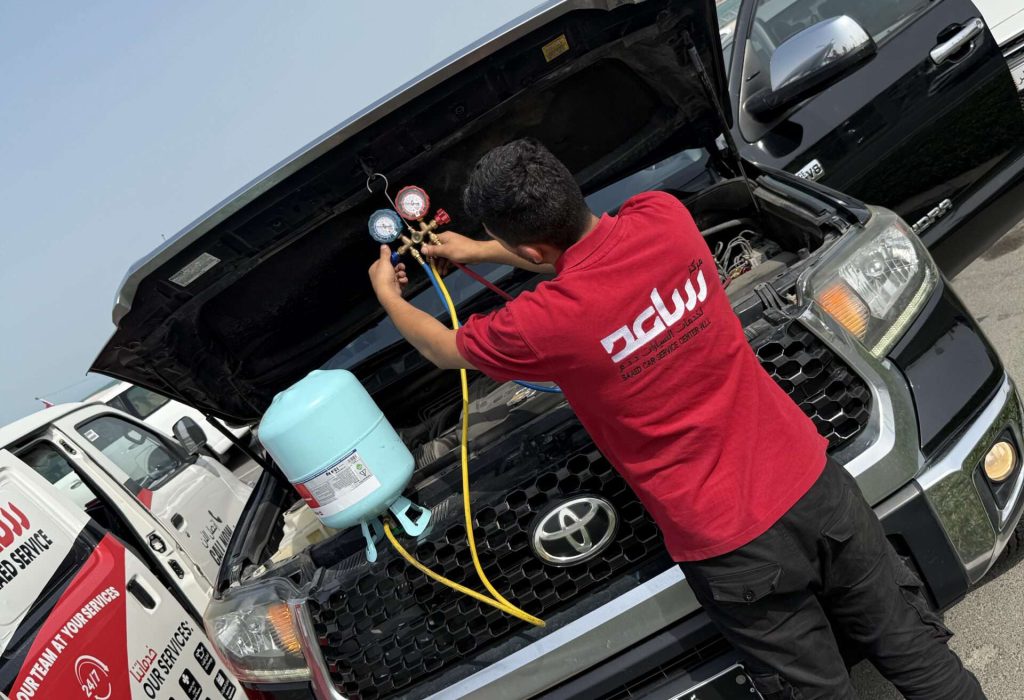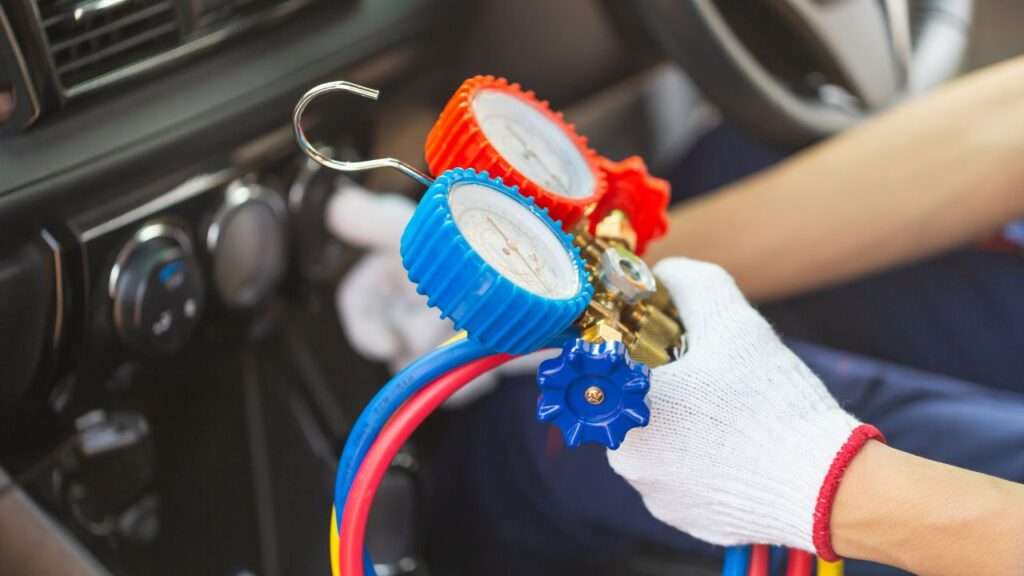The Chilling Truth: How Car AC Evolved in Qatar
Let’s be real.
In Qatar, your car’s AC is not a luxury—it’s life support.
Step outside in summer, and within five seconds, you’re melting like an ice cream left on the dashboard.
That first blast of cold air when you start your car? Pure magic.
But have you ever wondered what’s actually cooling you down?
Or why your AC suddenly stops working when you need it most?
Or why recharging your AC in an older car suddenly costs more than a weekend at the Pearl?
It all comes down to refrigerants—the invisible force behind your car’s ability to keep you from turning into a puddle.
And over the years, these refrigerants have changed big time.
Here’s everything you need to know about the evolution of car AC in Qatar—without the boring science lecture.

The Freon Days (Pre-1994): When AC Was Ice-Cold and Nobody Cared About the Ozone
If you drive a classic Land Cruiser, an old Mercedes 560SEL, or any pre-90s beast, your AC used to run on R-12 Freon.
This stuff was the gold standard.
It cooled like a dream. It lasted forever. It made even the hottest summer days feel like a five-star hotel lobby.
But there was one tiny problem…
It was eating the ozone layer alive.
Scientists found out that a single can of R-12 destroyed enough ozone to make sunscreen pointless.
By 1995, R-12 was banned worldwide faster than a tourist trying to wear shorts in a government building.
Still Driving an Old-School Classic? Here’s What You Need to Know:
- R-12 is illegal to produce—so unless you find a hidden stash from the 90s, you’re out of luck.
- Only specialist mechanics with government licenses can handle the last remaining R-12.
- It’s insanely expensive—over 100 times what it used to cost.
- Many classic car owners are switching to modern refrigerants—but that means modifying your system.
Still want to keep your car “original”? You’ll have to pay up or accept that your AC might just be a fancy fan now.
The R-134a Takeover (1994-2020): Cool, But Not Perfect
By the mid-90s, car manufacturers switched to R-134a—a new refrigerant that didn’t eat the ozone.
It was cheaper, widely available, and kept cars cool enough—but not quite as well as the old stuff.
If you drive a Toyota Prado, Nissan Patrol, or BMW from the early 2000s, this is probably what’s in your AC system.
Signs Your Car Uses R-134a:
- There’s a label under the hood that says “R-134a.”
- Service ports look different from R-12 models.
- Your car was built between 1994 and 2020.
The problem? Scientists later realized that R-134a was still bad for the environment.
Not as bad as R-12, but still 1,430 times worse than CO2 for global warming.
So guess what happened? Yep—another refrigerant change.

The R-1234yf Era (2020-Present): Cleaner, Greener, and More Expensive
If you drive a new Lexus, Range Rover, or Tesla, congratulations—your AC now runs on R-1234yf.
This refrigerant is 99.7% better for the environment compared to R-134a.
Sounds great, right? Well… there’s a catch.
R-1234yf vs. R-134a: What’s the Difference?
- Way more expensive. Recharging costs up to 10 times more than R-134a.
- Slightly slower cooling. Your AC might take a few extra seconds to get ice-cold.
- Newer tech. Your car’s compressor cycles differently, and you might hear strange new sounds from your AC.
- Flammable. Yeah, this one’s mildly flammable. But don’t worry—manufacturers designed the system to prevent any real issues.
So if you just bought a new car and thought, “Why is my AC recharge so expensive now?”—blame the refrigerant change.
How to Check What Refrigerant Your Car Uses
Not sure what’s in your AC? Here’s how to find out:
✅ Check under the hood—there’s usually a sticker near the radiator.
✅ Look in the owner’s manual.
✅ Ask a mechanic. They can tell in seconds.
✅ Check your car’s model year:
- Pre-1994: R-12 (Freon)
- 1994-2020: R-134a
- 2020+: R-1234yf
And no, you can’t just mix refrigerants like a cocktail.
Using the wrong one will wreck your AC system faster than a sandstorm wrecks a fresh car wash.
What Qatar Drivers NEED to Know About Car AC Maintenance
Let’s be real—Qatar’s heat is brutal on AC systems.
If you want cold air all year round, you need to stay on top of maintenance.
Top Reasons Your AC Might Be Weak (Even With a Full Refrigerant Charge):
🔹 Leaky Seals. AC refrigerant leaks faster in extreme heat—15% can disappear every 5-7 years.
🔹 Clogged Filters. If your AC filter is dirty, your system will work harder and cool less.
🔹 Bad Compressor. The compressor is your AC’s heart. If it fails, your AC is completely useless.
🔹 Low Refrigerant. If you feel warm air, your system might just need a recharge—but only with the right refrigerant.
DO NOT wait until it’s 50°C outside to check if your AC works. By then, everyone in Qatar is booking AC repairs, and you’ll be sweating in traffic. Book your Car AC Repair service NOW!
The Future of Car AC in Qatar
Tech is evolving fast. The next wave of car AC will be:
✅ CO2-based systems (R-744) – Already used in some luxury cars.
✅ Heat pump technology in electric vehicles – Keeps cabins cool without draining the battery.
✅ Smart AC that cools only occupied seats – No more freezing empty seats.
✅ Surface cooling instead of air conditioning – Think cold steering wheels and seats instead of blasting air.
The goal? Better cooling, lower energy use, and refrigerants that don’t mess with the planet.
Keep Your AC Running Like a Dream
Look, if your AC isn’t working properly, your car is basically an oven on wheels.
Don’t wait for summer to find out it’s struggling.
❄️ Check your AC NOW before Qatar’s heat kicks into high gear.
❄️ Need a pro? Book our mobile car AC service with our certified AC technician. CALL NOW
Your future self—and your sweat-free shirt—will thank you.
